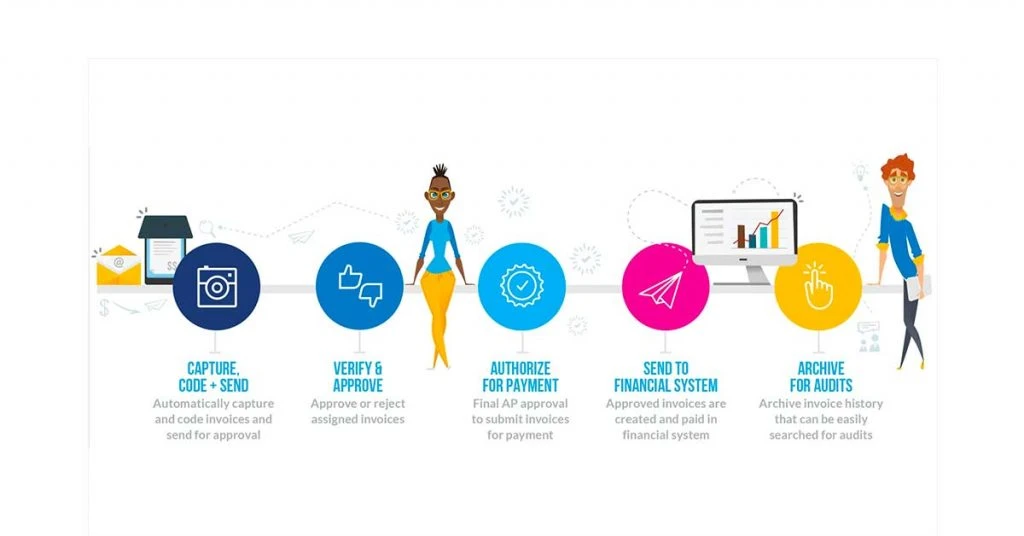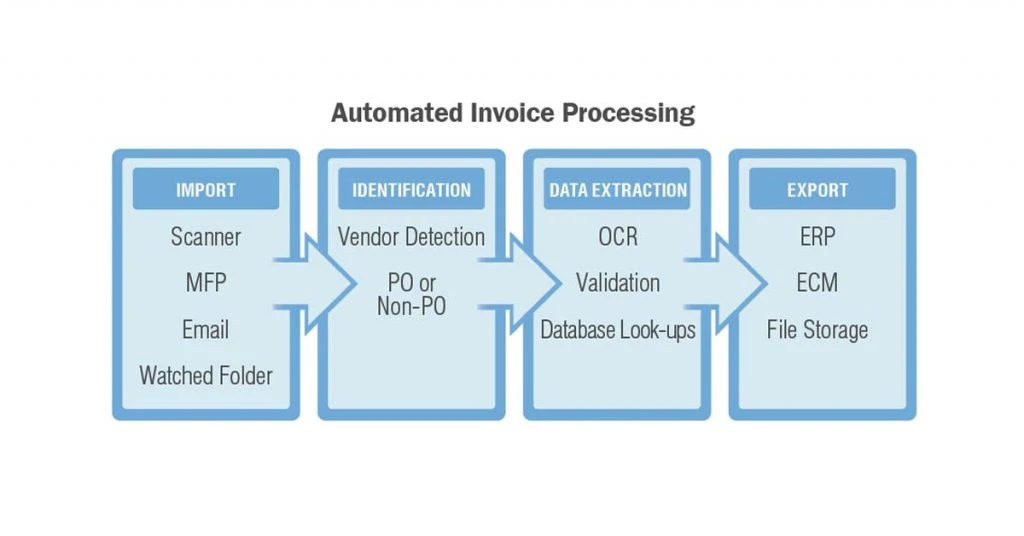An invoice is a time-stamped commercial document that records a sale transaction. It indicates the list of products and services, quantities, and the price the parties involved in the transaction agreed upon. In addition, all the terms of the transaction and available payment methods are stated in the invoice. In this article we’re gonna be discussing about automated invoice processing and benfits.
A seller issues invoices to a buyer. These act as a record for both the businesses and the customers. For most businesses, it is a necessary part of making deals. In addition, invoice processing helps them stay organized and know about overdue payments.
However, this can be quite a time consuming and complex, especially for large businesses. Therefore, quick payment of invoices is necessary for small businesses to cover expenses and maintain a steady cash flow. This article describes how organizations can process invoices accurately and timely to ensure quick payments.
What Is Invoice Processing in Accounting?
Invoice processing is a business operation that involves all steps from receiving an invoice to paying it for managing vendors or suppliers. The accounts payable department does the work of filing, recording, and approving bills/ invoices before payment.

Businesses follow an invoice processing flowchart that includes the steps involved in processing invoices for the vendors. For example, accounts payable (AP) invoices are created when the business owes money to others, while accounts receivable (AR) invoices detail how much money the customers owe to a business.
What are the Steps to Process an Invoice for Payment?

Depending on the size of a business, the rules for processing payment can be simple to complex. For example, accounts payable (AP) processing is done to pay suppliers and vendors for goods and services purchased by the company.
Step 1: Receive Invoice from a Vendor
Once the work is complete, services or products are delivered, vendors send the invoice. All relevant information listed in the invoice is then input into the accounting system. This data entry work is usually done manually by AP clerks, businesses, or even receptionists in smaller businesses.
Step 2: Place/Scan Vendor Invoice Copy into the Filing System
As a proper procedure for audit purposes, the concerned person copies or scans the invoice into the paper or electronic filing system. The copies are well organized in cabinets or AP software so that the person-in-charge or the auditors can locate them easily and quickly, if necessary.
The benefit of AP software is that it can automate invoice processing, entire process to reduce the burden on workers. Backup is important if any discrepancy occurs later.
Step 3: Invoice Approval
Now, categorize the invoice by identifying and linking the related purchasing documents like order receipts. Invoices can be PO (have a purchase requisition or purchase order) or non-PO (without an associated request or purchase order).
If an invoice fails the validation due to missing information or other discrepancies, it should be fixed and then rerouted for approval.
After validation and matching, it gets approved or rejected by the authorized person. The AP clerk or bookkeeper rechecks the invoice for small businesses and sends it to the authority for approval.
Large businesses have several rules and multiple people to authorize the invoice. The approver depends on the information in purchasing documents.
On paper, approval can be in the form of a signature on the document, while on email, the approver replies in the affirmative to proceed. AP automation software provides better security from signature forges and prevents vendors from getting unpaid by reducing the complexity.
Related Categories: Billing And Invoicing Software | Medical Billing Software | POS Software
Step 4: Invoice Payment
After approval, the invoice is sent to the vendor or customer for payment, which takes some time. You can process invoices for payment through usual payment methods like ACH, cheque, and wire transfer.
You can also archive invoices and payment information in the general ledger and for audits. Finally, the invoice can be closed.
What are the Challenges with Manual Invoice Processing?
Manual invoice processing results in several process gaps and inefficiencies. Some of the challenges are:
Time consuming: Businesses face frequent delays during manual routing and data entry compared to automated invoice processing. This is especially true when multiple people have to approve a single invoice.
Data entry errors: There is a high probability of data errors during manual entry, leading to penalties.
Little visibility: The data is stored in rows of filing cabinets and offers little to no visibility into the important information. It is difficult to keep track of outstanding invoice approvals. There are inaccurate cash flow forecasts, unexpected cash crunches and liquidity shortages.
Costly processes: The employees’ assigned invoice processing to spend most of their time entering data that could have been better used. This costs your business money.
Fraud-prone: It is easy to forge an approval’s initials or signature on paper. Along with fraud, there are several genuine errors like duplicate payment, overpayment, and missed documents.
Late payment penalties: There is a constant chase after approvals. Invoices get lost, accidentally deleted, or forgotten on papers or emails. This results in unpaid vendors and late payment penalties.
How to Automate Invoice Processing?
An automated invoice processing system is the process of extracting data from invoices in your system and sending it to ERP so that processing a payment is done in a few clicks. For accounts payable automation, you can take a series of steps and get incremental benefits.

First, create policies and procedures, then implement the technology. This way, you do not have to immediately make drastic changes to existing systems for the AP invoicing process.
Analyze the Current Workflow
Understand the process from receiving an invoice to validation and coding. Analyze the time consumed in processing an invoice, the number of invoices processed per year, cost per transaction, and so on.
If you have part electronic and rest paper invoices, know the distribution. Then, you will understand where the bottlenecks and delays exist and how to improve them.
Centralize the Management
Establish a centralized service for invoice management and ask suppliers/vendors to send the invoices to the accounts department. Ensure that all invoices are captured in electronic form. Scan and index the existing documents to streamline the entire process.
Create Standard Policies
Before invoice automation, clarify to your employees how invoices should be processed by defining standard policies and procedures. For example, developing the approval workflow, discrepancy resolution workflow, matching criteria, and so on.
Start Automating
Select and implement the right billing & invoicing software that meets your business requirement and enables you to automate your policies and procedures. The idea is first to have a consistent invoice automation process irrespective of the number of ways you have initially captured invoices.
You can then work on improving the front-end capture process. For that, you can implement electronic invoices or trading networks. You can also add functions like invoice upload.
Establish Self-Service Vendor/Supplier Portal
Create a self-service portal so that suppliers can track the status at all times. This will reduce the time spent on responding to vendor/supplier queries regarding their invoice payment.
The self-service vendor portal makes the invoice processing process quicker, and you have better spend analysis data for supplier base consolidation and other sourcing activities.
When procurement people have the requisite data, you can request early payment discounts at the time of agreeing to new contracts. If a supplier already offers such discounts, you can claim it.
Benefits of Automated Invoice Processing and Billing

Billing & Invoicing Software merge data capture, automatic routing, contract management, and integration capabilities in one platform.
Both accounts payable and account receivable automation aim to prevent repetitive manual processes. The main advantages of billing and invoicing software are:
Saves Time and Cost
Manual invoicing makes it difficult to avoid invoicing errors, compliance issues, revenue leakage, and vendor management issues. In addition, many businesses use disconnected systems, resulting in error-prone tasks and the inability to achieve customer satisfaction.
Billing and invoicing software ensures streamlined and automated invoice processing and improves employee productivity by focusing on less redundant tasks. In addition, by automating the process of capturing, coding, and sending invoices for approval, you reduce the chance of error and fraud.
Scalable Billing Infrastructure
As your business grows, it becomes difficult to manage growing customers, support different pricing options, experiment with trials, and more quickly. In addition, it is difficult to give customers the option to change what they want amid the ongoing billing cycle.
Billing and invoicing software supports usage-based billing, consolidated invoicing, and integrates with multiple payment gateways. With usage-based billing, everything is detailed in a simple format for customers to ensure transparency.
Consolidated invoicing is useful when a single customer is charged for multiple services. It prevents the inefficiency of sending individual invoices for every charge to the customer.
Prevents Payment Failure & Revenue Loss
Customers may not have sufficient funds at the time of payment or face connectivity issues when using a single payment gateway. Such results in the decline of payments.
Billing software enables dunning to send payment reminders and retry attempts to customers via backup methods. This enables market expansion and minimizes the incidence of payment failures when using one method.
Ensures Regulatory Compliance
Compliance is a must as billing systems collect sensitive personal and payment information. If you do not handle customer data securely, you lose the trust of your customers and partners.
Billing and invoicing software minimizes compliance problems and ensures secure payments. In addition, you can create variations of a product in various currencies and assign relevant tax codes for specific markets.
Helps Recognize Revenue Sources
Understanding the relation of time and resources spent concerning revenue generation becomes difficult as a business grows.
For large-scale reconciliation, full-scale automation is essential. This is possible via billing and invoicing software. The software lets you automatically sync invoices and other details.
Improved Reporting & Visibility
Businesses cannot make the right decisions if they do not know about the feature attracting the most revenue, impact of change in pricing plans, and net profit/ loss amount. Unfortunately, this is not easy to analyze using manual invoices or via an Excel sheet.
Billing and invoicing software provides reports and dashboards that provide a 360-degree analysis of these metrics to help you understand the best revenue improvement opportunities.
You can avoid cash flow issues and late payment penalties by real-time tracking and better control over internal functions. In addition, you can identify the cause of your losses quickly and take action to avoid them further by taking into account all complex factors.
Higher Customer Satisfaction
Customers have higher satisfaction choosing a vendor that enables them to switch to a different plan, attach add-ons, and do more during the billing cycle. If you try to create customized invoices, you are forced to start with the entire process again for making the smallest of changes for each customer.
You can customize your invoices to suit your brand and customers- like address format, colour scheme, and so on. In addition, you can manage and track promotions, offer custom discounts, and make other changes for the long-term satisfaction and loyalty of customers in different geographic areas. You also have the option of advance invoicing to avoid sudden budget issues.
Third-Party Integrations
Billing is not just the finance department’s business. It spans different business functions such as reporting and analytics, sales, marketing, and customer support. Disconnected systems make it difficult for different verticals to get the information they want instantly.
Billing and invoicing software work as a single platform that can streamline the invoicing process across all business functions like analytics, collaboration, e-commerce, etc. You can also integrate your existing systems like CRM and ERP systems to prevent their complete replacement.
Eases Global Business Expansion
There are several challenges with international transactions, like meeting local tax requirements and compliance, multiple currencies, multiple payment methods, and so on. You will have a lot of issues in expanding your market if you rely on manual or disconnected systems.
Billing and invoicing software enable you to grow your business internationally by supporting flexible payment systems. For example, it can automate tax computations, multi-currency pricing, global payment gateways, and so on.
Conclusion
Quick payments due to faster and automated invoice processing can improve your company’s financial health and make the accounting process easier. However, businesses must encourage clients to pay their bills on time or even ahead of the invoice due date.
It is crucial to send invoices immediately after completing work, offer convenient payment methods and follow up soon after the due date.
FAQs
What are the steps for online invoice creation?
First, ensure the order is completed. Choose a template in the billing & invoicing software and customize it as per your needs. Include data like name and address of your and the customer, invoice number, issue date, description, quantity, due date, and so on.
If it is a recurring payment, you can create it in seconds. Include online payment methods before sending. Finally, check the invoice and email it to the customer.What is the accounts payable cycle?
The accounts payable cycle is a part of the procure-to-pay process that includes the entire bookkeeping process of finishing a purchase. AP process flow consists of capturing invoice data, coding correct invoices, approving invoices, matching invoices to purchase orders, and finally posting for payments.
What are the steps for accounts payable processing?
Accounts payable processing includes steps like creating charts of accounts, setting up vendors' details, checking and entering invoice details, and processing the due payments.
How to fasten the accounts payable process?
You can improve your speed by using AP automation software. Opt for electronic invoices and move towards a paperless AP system. You can use OCR technology for data capture and automate payments. Integration of digital invoice processing with accounting software helps in tracking invoices and payments.
How do I automate an invoice processing?
Automating your invoice processing process is a smart move, considering that it helps in managing the invoice & payment workflow.
Billing & invoicing software helps in automated invoice generation with auto-filled data. You can further share the invoices with clients and ensure timely payment with reminders and the payment link.What is automated invoicing software?
Automated invoicing system helps in extracting the invoice data and updating the relevant information on the AP (accounts payable) system.
Automated invoicing software automates the entire invoice processing process right from the invoice generation to payment and bank reconciliation.
Ayushee is currently pursuing MBA Business Analytics from SCMHRD, Pune with a strong background in Electronics and Communication Engineering from IGDTUW. She has 2 plus years of full-time work experience as an SEO content writer and a Technology Journalist with a keen interest the amalgamation of business and... Read more





























